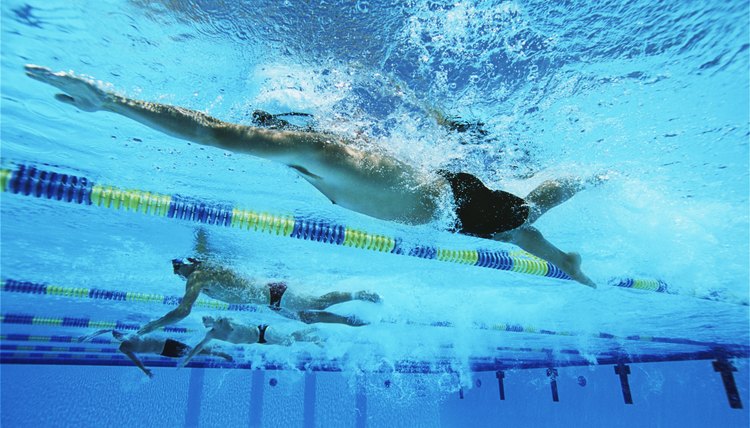How Does Swimwear Have an Effect on the Swimmer's Performance?

Swimming performance is measured to the nearest 0.01 second, with swimmers in the top 15 separated by only 0.10 second. Considering this, it should be of no surprise that swimmers are often looking for any way they can to improve performance. Which type of swimsuit you choose can make a dramatic difference to your performance.
It's About Physics
When you go swimming, one thing that slows you down is the drag of your body, or what you're wearing. This means that when you are in the water, the kind of swimwear you have can slow you down by creating more drag, or speed you up by reducing drag. One reason swimmers are always very physically slender is to reduce drag. Research published in the February edition of “Medicine and Science in Sports and Exercise” demonstrated that wearing swimsuits made of different materials can increase or reduce drag by around 10 to 15 percent.
Making It Easier
Swimming is a very energetically expensive form of exercise. Reducing the drag of your body not only makes you faster, it also makes it easier to swim at the same speeds. Consequently, if you were wearing the correct swimsuit, you may be able to swim faster and farther. This has implications for relay team events as well as maximal sprint events.
A Matter of Technology
NASA and several universities carried out research that led to development of faster swimsuits. The scientists studied some of the fastest swimming marine animals and tried to mimic their abilities with technology. The resultant product was made out of polyurethane, which reduces drag significantly and allows the swimmer to be faster. Traditional swimsuits are typically made from lycra, which absorbs air and water, consequently slowing you down in the water.
Controversy
The swimsuits that enable swimmers to swim at very high speeds were developed originally in 2008 by Speedo and NASA. The very first suits were called LZR and within the first week of their launch, swimmers broke three world records wearing them. Later, at the FINA world championships in Rome, swimmers wearing the new suits set 29 world records in only five days. Consequently in 2010, FINA, the governing body for swimming, banned use of the suits. The use of technology to make swimsuits better continues to be a controversial topic.
References
- “Medicine and Science in Sports and Exercise;” Effect of Swim Suit Design on Passive Drag; J. Molledorf, et al. February 2004
- BBC Sport: Hi-tech suits banned from January; July 31, 2009
- Science Daily: Engineering The World's Fastest Swimsuit
Writer Bio
Mike Sweeney has been writing since 2007 and has done work for the "Journal of Sports Sciences." He has experience working with athletes and non-athletes, helping them achieve their goals. He also runs a sports camp for children with disabilities. Sweeney holds a Foundation Degree Sciences and a Bachelor of Science, both in sports and exercise science from Loughborough College.
